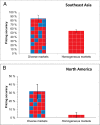Ethnic diversity deflates price bubbles
- PMID: 25404313
- PMCID: PMC4284549
- DOI: 10.1073/pnas.1407301111
Ethnic diversity deflates price bubbles
Abstract
Markets are central to modern society, so their failures can be devastating. Here, we examine a prominent failure: price bubbles. Bubbles emerge when traders err collectively in pricing, causing misfit between market prices and the true values of assets. The causes of such collective errors remain elusive. We propose that bubbles are affected by ethnic homogeneity in the market and can be thwarted by diversity. In homogenous markets, traders place undue confidence in the decisions of others. Less likely to scrutinize others' decisions, traders are more likely to accept prices that deviate from true values. To test this, we constructed experimental markets in Southeast Asia and North America, where participants traded stocks to earn money. We randomly assigned participants to ethnically homogeneous or diverse markets. We find a marked difference: Across markets and locations, market prices fit true values 58% better in diverse markets. The effect is similar across sites, despite sizeable differences in culture and ethnic composition. Specifically, in homogenous markets, overpricing is higher as traders are more likely to accept speculative prices. Their pricing errors are more correlated than in diverse markets. In addition, when bubbles burst, homogenous markets crash more severely. The findings suggest that price bubbles arise not only from individual errors or financial conditions, but also from the social context of decision making. The evidence may inform public discussion on ethnic diversity: it may be beneficial not only for providing variety in perspectives and skills, but also because diversity facilitates friction that enhances deliberation and upends conformity.
Keywords: decision making; diversity; economics; markets; psychology; sociology.
Conflict of interest statement
The authors declare no conflict of interest.
Figures



Comment in
-
Downsides of social capital.Proc Natl Acad Sci U S A. 2014 Dec 30;111(52):18407-8. doi: 10.1073/pnas.1421888112. Epub 2014 Dec 22. Proc Natl Acad Sci U S A. 2014. PMID: 25535346 Free PMC article. No abstract available.
References
-
- North DC. Institutions. J Econ Perspect. 1991;5(1):97–112.
-
- Davis GF. 2009. Managed by the Markets: How Finance Re-shaped America (Oxford Univ Press, Oxford)
-
- Hayek FA. The use of knowledge in society. Am Econ Rev. 1945;35(4):519–530.
-
- King RR, Smith VL, Williams AW, van Boening MV. The robustness of bubbles and crashes in experimental stock markets. In: Day RH, Chen P, editors. Nonlinear Dynamics and Evolutionary Economics. Oxford Univ Press; Oxford: 1993. pp. 183–200.
-
- White EN. The stock market boom and crash of 1929 revisited. J Econ Perspect. 1990;4(2):67–83.
Publication types
MeSH terms
LinkOut - more resources
Full Text Sources
Other Literature Sources

